Class 11-science H C VERMA Solutions Physics Chapter 13 - Fluid Mechanics
Fluid Mechanics Exercise 273
Solution 1
Pressure due to water
⇒
P = h![]() g = 4 ×
1000 ×
10
g = 4 ×
1000 ×
10
= 40000 N/m²
Since pressure is proportional to height of water. If tap is open height of water decreases, so pressure decreases.
Solution 2
(a)

![]()
![]()
= ![]()
=![]()
(b) Pressure at bottom of mercury
![]()
![]()
![]()
Solution 3
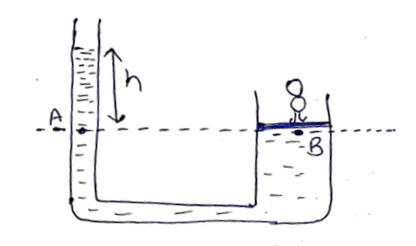
![]()
![]()
![]()
![]()
Solution 4
(a) ![]()
![]()
![]()
(b)

Cylindrical water column is balanced by bottom of glass and remaining by side wall.
![]()
![]()
![]()
![]()
![]()
Solution 5
Now atmospheric pressure will not act.
(a) ![]()
![]()
(b)![]()
![]()
No change will occur in answer if height, area and volume is kept same irrespective of shape of container.
Solution 6
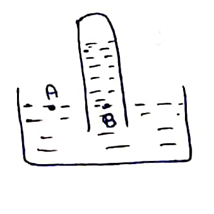
![]()
![]()
![]()
![]()
Fluid Mechanics Exercise 274
Solution 7
F= PA
![]() = 107 N/m2
= 107 N/m2
Force depends upon area not on orientation.
Solution 8
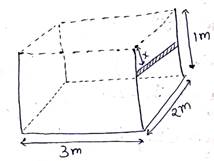
(a) ![]()
![]() = 60000N
= 60000N
(b) Force of strip of width 'dx'
![]()
![]()
![]() = x×1000×10×2dx
= x×1000×10×2dx
= 20,000 xdx
(c) Torque = force × distance
![]()
(d)Total force by water on side wall

![]()
(e) Total torque on side wall

Solution 9
![]()
![]()
Weight difference in air and water is due to buoyancy force
![]()
![]()
![]()
Solving, equation (1) and (2)
![]()
Solution 10
![]()
Now,
![]()
![]()
![]()
![]()
Solution 11
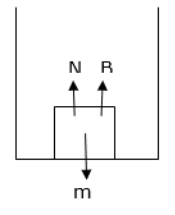
N + B = mg
⇒N = mg - B
= 160 ×
10-3 × 10 - V![]() wg
wg
= ![]()
= ![]()
⇒N = 1.4
Solution 12
(a) In equilibrium,
Weight of boat = Buoyancy force
![]()
![]()
![]()
(b) Let Vfbe the volume of boat filled with water before water starts coming in from the sides. So,
![]()
![]()
![]()
Fraction
of boat's volume filled = ![]() =
=![]()
Solution 13
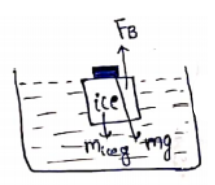
Let side of ice cube be x.
In equilibrium,
![]() g + mg =
g + mg =
![]() g
g
(![]() x3)
+ 0.5 =x3
x3)
+ 0.5 =x3![]() w
w
(0.9x103)x3 + 0.5 = x3(103)
X=17 cm
Solution 14
Volume of ice inside kerosene oil and water be Vk and Vwrespectively
Vice = Vk + Vw ----- (1)
Since, Ice is in equilibrium,
Miceg = FB
![]()
![]() g=
g=![]() g+
g+![]() g
g![]()
![]() (0.9)=
(0.9)=![]() --------- (2)
--------- (2)
Solving equation (1) and (2)
![]() =1
=1
Solution 15
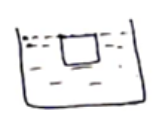
Let external edge of iron cube be x
In equilibrium,
Weight of iron cube = Buyoncy force
![]() g =
g = ![]() g
g
6x[(0.1)x2(8000)] = x3(1000)
X=4.8cm
Solution 16
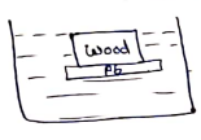
In equilibrium
(![]() +
+![]() )g
= (
)g
= (![]() +
+![]() )
)![]() g
g
(0.2+![]() )=(
)=(![]() /
/![]() +
+ ![]() /
/![]() )
)![]()
(0.2+mpb) = (0.2/0.8 + mpb/11.3)
mpb = 0.0548 kg
Solution 17
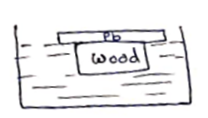
In equilibrium,
mpbg + mwg = Vwood
![]() water
g
water
g
mpb +200 = 200/0.8
mpb = 50g
Solution 18
Initially,
mg = ![]()
![]() b
(12)3g=(12)2(12/5)(
b
(12)3g=(12)2(12/5)(![]() )g
)g
![]() =13.6/5
gm/cc
=13.6/5
gm/cc
Let x be the height of water column after the water is poured
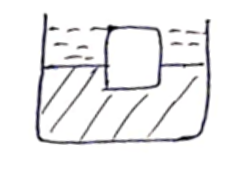
mg=x(12)2![]() +(12-x)(12)2
+(12-x)(12)2![]() g
g
(13.6/5)(12)3 = x(12)2+(12-x)(12)2(13.6)
X=10.4cm
Solution 19
In equilibrium,
mg=![]()
![]() [
[![]() -
- ![]() (6)3]=
(6)3]= ![]()
![]() g
g
![]() =0.865
=0.865![]()
![]() =865kg/m3
=865kg/m3
Solution 20
(![]() +
+![]() )g=V
)g=V![]()
![]() (5)3
(5)3![]() + 0.1×1000 =
+ 0.1×1000 = ![]() (5)3
(5)3
![]() =
0.8gm/cc
=
0.8gm/cc
Solution 21
Reading by
spring balance = mg-buoyancy![]() force
force
= mg - V![]() g
g
= mg - ![]()
![]() g
g
![]() = [1 - (1/7800)(1.293)]g
= [1 - (1/7800)(1.293)]g
![]() = [1 - (1/800)(1.293)]g
= [1 - (1/800)(1.293)]g
![]() = 1.0015
= 1.0015
Solution 22
T=2![]()
Water behaves as spring having spring
constant K=A![]() g
g
T=2![]()
= 2![]()
T= 0.5 sec
Solution 23

In equilibrium
Kx+V![]() wg = mg
wg = mg
(500 × ![]() )x +
)x + ![]() (5)2(
(5)2(![]() )(1)(980)
=
)(1)(980)
= ![]() (5)2(20)(8)(980)
(5)2(20)(8)(980)
X=23.5 cm
T=2![]()
Water behaves as spring of spring
constant ![]() = A
= A![]() g
g
Now, spring and water spring are in parallel combination
![]() =
= ![]() +
+ ![]()
T = 2![]()
T= 0.935 sec
Solution 24
(a)
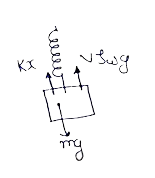
In equilibrium,
Kx + V![]() g = mg
g = mg
(50)x+(0.5/800)(1000)(10) = (0.5)(10)
X=-0.025 m
X= - 2.5 cm
So, spring will be in compression
(b)Since, system is completely inside water so unbalanced force will be due to spring only. Buyoncy force doesn't change
T=2![]()
= 2![]()
T = ![]() /5
/5![]()
Solution 25
Let the length of the edge of the ice block when it just leaves contact with the bottom of glass be x and height of water after melting be h.
Weight = Buoyancy force
(x)3![]() g = (x2h)
g = (x2h)![]() g
g
0.9x = h ----- (1)
Volume of water formed by melting of ice
(4)3
- (x)3 = ![]() r2h
- x2h ------ (2)
r2h
- x2h ------ (2)
Solving equation (1) and (2)
X=2.26cm
Solution 26
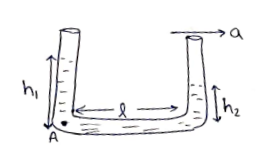
![]() =
= ![]() +
+![]() g =
g = ![]() +
+![]() g+
g+![]()
![]() -
- ![]() = la/g
= la/g
Solution 27
From continuity equation
A1V1+ A2V2 = A3V3
(12×d)(20) +
(8×d)(16)
= (16×d)(![]() )
)
![]() = 23 km/hr
= 23 km/hr
Solution 28
A) Discharge = Area × velocity
(1×10-6) = (4×10-6)![]()
![]() = 0.25 m/s
= 0.25 m/s
B) A1V1 = A2V2
(4)(0.25) = (2)![]()
![]() = 0.5 m/s
= 0.5 m/s
C) From Bernoulli's equation
PA + ![]() = PB +
= PB + ![]()
PA + ![]() = PB +
= PB + ![]()
PA - PB = 94 N/m2
Solution 29
(a) VA = 0.25 m/s
(b) VB = 0.5 m/s
(c) PA + ![]() +
+![]() ghA
= PB +
ghA
= PB + ![]() +
+![]() ghB
ghB
PA + ![]() = PB +
= PB + ![]() +1000×10×(hB-hA)
+1000×10×(hB-hA)
[here, hB-hA=![]() cm]
cm]
PA - PB = 0 N/m2
Solution 30
(a) VA = 0.25 m/s
(b) VB = 0.5 m/s
(c) PA + ![]() +
+![]() ghA
= PB +
ghA
= PB + ![]() +
+![]() ghB
ghB
PA + ![]() = PB +
= PB + ![]() +1000×10×(hB-hA)
+1000×10×(hB-hA)
[here, hB-hA=![]() cm]
cm]
PA - PB = 188 N/m2
Solution 31
(a) AaVa = AbVb
(1)(10) = (0.5)(Vb)
Vb = 20 cm/s
(b) PA + ![]() +
+![]() ghA
= PB +
ghA
= PB + ![]() +
+![]() ghB
ghB
PA + ![]() +1x1000xhA= PB +
+1x1000xhA= PB +![]() +1x1000xhB
+1x1000xhB
[here, hB-hA=5cm]
PB-PA = 4850 dyne/cm2
PB-PA = 485 N/m2
Solution 32
AaVa = AbVb
4Va = 2Vb
2Va = Vb ----- (1)
PA + ![]() +
+![]() ghA
= PB +
ghA
= PB + ![]() +
+![]() ghB
ghB
PA + ![]() = PB +
= PB +![]() [here, hA=hB=0cm]
[here, hA=hB=0cm]
PA-PB = ![]()
2×1×1000
= ![]()
VA = 36.5 cm/sec
∴ Rate of discharge = VAAa
= (36.5)(4)
Q = 146 cm3/sec
Solution 33
Q = AaVa = AbVb
500 = 5(Va) = 2(Vb)
Va = 100 cm/sec
Vb = 250 cm/sec
PA + ![]() = PB +
= PB + ![]()
PA - PB = ![]() (VB2
- VA2)
(VB2
- VA2)
980 × 13.6 ×
h = ![]() [(250)2 - (100)2]
[(250)2 - (100)2]
h = 1.97 cm
Solution 34
(a) V = ![]()
= ![]()
V = 4m/s
(b) V = ![]()
= ![]()
V = ![]() m/s
m/s
(c) Q = ![]() =
av
=
av
dV = (2mm2)(![]() )dt
)dt
(d) dV
= -Adh = a(![]() )dt
)dt
![]() -=
-= ![]()
t= 6.5 hrs
Solution 35
Let h be the height of hole from bottom of tank
V = ![]()
T = ![]()
∴ R = vT
= ![]()
To maximize Range,
![]() = 0
= 0
H-2h = 0
h= ![]()

